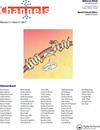The GoSlo family of BK channel activators: A no-go for γ subunits?
IF 3.2
3区 生物学
Q2 BIOCHEMISTRY & MOLECULAR BIOLOGY
引用次数: 0
Abstract
Large conductance Ca2C-activated KC channels (slo, MaxiK or BK channels) play fundamental physiological roles in a large variety of tissues including nerve, muscle and endocrine cells. BK open probability is controlled synergistically by transmembrane voltage and concentration of intracellular Ca2C. This intrinsic property enables them to act as couplers of Ca2C and membrane voltage signaling, providing a negative feedback mechanism controlling Ca2C influx to the cell. Consequently, BK channels are key regulators of neuronal action potential firing, neurotransmitter release or smooth muscle contractile tone. Inherited defects in BK channels function lead to disease including seizure and epilepsy, urinary incontinence or high blood pressure. Many years of research have contributed significantly to our understanding of the molecular basis of BK channels gating and ion conduction, as well as the regulation of channel function in different cell types and tissues. These advances were paralleled by a growing interest in developing BK channel openers due to their therapeutic potential in disorders characterized by hyperexcitability and smooth muscle dysfunction. The therapeutic interest of several natural and synthetic compounds has been amply described in the literature as the basis of potential treatment strategies for epilepsy, ischemic heart disease, pulmonary disease, erectile dysfunction and bladder instability. Among them is a series of anilinoanthraquinone analogs (the GoSlo-SR family), described as potent activators of BK channels in bladder smooth muscle cells, now further characterized by Kshatri et al. Despite the large number of pre-clinical and basic research studies, the clinical relevance of BK channel activators remains unclear. This lack of success relays partly in the poor selectivity of the compounds to target channels at specific tissues in vivo, which may ultimately be due to their ubiquitous expression and functional diversity. The tissue-specific functional diversity of BK channels arises from different mechanisms, including alternative splicing, post-translational modifications or metabolic regulation. Furthermore, association of the pore-forming a subunits with tissue-specific regulatory subunits affects Ca2Cand voltage-sensitivity of the channels, and their pharmacology. Coexpression of one of 4 different b subunits with BKa explains to a large extent the characteristics of the BK currents observed in the specific tissues where b subunits are expressed (e.g. b1 is mainly found in muscle and b4 in brain). Only a few years ago, a novel family of regulatory subunits (g) was reported, with a predicted topology of a single transmembrane domain and a characteristic leucine-rich repeat (LRR) extracellular domain. All four members of the g-subunit family induce shifts in BK channel’s voltage dependence of activation to different extents, resulting in large channel open probabilities even at resting potential and physiological intracellular Ca2C concentrations. Similarly to b subunits, g subunits show tissue-specific expression patterns. In the search for new BK channel activators it is thus essential to take into account the composition of native channels in different tissues. Pharmacology must be assessed not only in BKa hometramers, but also in BK heteromers containing regulatory subunits. Specificity must be studied in all plausible combinations with physiological relevance. Bearing this in mind, Kshatri et alGoSlo家族的BK通道激活剂:γ亚基的禁忌?
ca2c激活的KC通道(slo、MaxiK或BK通道)在包括神经、肌肉和内分泌细胞在内的多种组织中发挥着重要的生理作用。BK打开概率受跨膜电压和胞内Ca2C浓度的协同控制。这种固有特性使它们能够作为Ca2C和膜电压信号的耦合器,提供一种控制Ca2C流入细胞的负反馈机制。因此,BK通道是神经元动作电位放电、神经递质释放或平滑肌收缩张力的关键调节因子。BK通道功能的遗传缺陷会导致癫痫发作、尿失禁或高血压等疾病。多年的研究为我们了解BK通道门控和离子传导的分子基础以及不同细胞类型和组织中通道功能的调控做出了重要贡献。与这些进展并行的是,由于BK通道打开剂具有治疗以高兴奋性和平滑肌功能障碍为特征的疾病的潜力,人们对开发BK通道打开剂越来越感兴趣。几种天然和合成化合物的治疗价值在文献中被充分描述为癫痫、缺血性心脏病、肺病、勃起功能障碍和膀胱不稳定的潜在治疗策略的基础。其中包括一系列苯胺蒽醌类似物(GoSlo-SR家族),它们被描述为膀胱平滑肌细胞中BK通道的有效激活剂,Kshatri等人现在进一步对其进行了表征。尽管有大量的临床前和基础研究,但BK通道激活剂的临床相关性仍不清楚。这种缺乏成功的部分原因在于化合物对体内特定组织靶向通道的选择性较差,这最终可能是由于它们无处不在的表达和功能多样性。BK通道的组织特异性功能多样性源于不同的机制,包括选择性剪接、翻译后修饰或代谢调节。此外,孔隙形成亚基与组织特异性调节亚基的关联影响通道的ca2c和电压敏感性及其药理学。4种不同b亚基中的一种与BKa的共表达在很大程度上解释了在b亚基表达的特定组织中观察到的BK电流的特征(例如b1主要存在于肌肉中,b4主要存在于大脑中)。就在几年前,一个新的调控亚基家族(g)被报道,其预测的拓扑结构是单个跨膜结构域和一个特征的富含亮氨酸重复结构域(LRR)胞外结构域。g亚基家族的所有四种成员都不同程度地诱导BK通道的电压依赖性激活的变化,导致即使在静息电位和生理细胞内Ca2C浓度下,通道开放概率也很大。与b亚基类似,g亚基表现出组织特异性表达模式。因此,在寻找新的BK通道激活剂时,必须考虑到不同组织中天然通道的组成。药理学必须评估,不仅在BKa同源,但在BK异构体含有调控亚基。特异性必须在所有合理的与生理相关的组合中进行研究。记住这一点,Kshatri等人
本文章由计算机程序翻译,如有差异,请以英文原文为准。
求助全文
约1分钟内获得全文
求助全文
来源期刊

Channels
生物-生化与分子生物学
CiteScore
5.90
自引率
0.00%
发文量
21
审稿时长
6-12 weeks
期刊介绍:
Channels is an open access journal for all aspects of ion channel research. The journal publishes high quality papers that shed new light on ion channel and ion transporter/exchanger function, structure, biophysics, pharmacology, and regulation in health and disease.
Channels welcomes interdisciplinary approaches that address ion channel physiology in areas such as neuroscience, cardiovascular sciences, cancer research, endocrinology, and gastroenterology. Our aim is to foster communication among the ion channel and transporter communities and facilitate the advancement of the field.
 求助内容:
求助内容: 应助结果提醒方式:
应助结果提醒方式:


